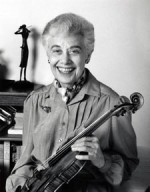Column Name
Title
Louise Behrend, a violinist and teacher who introduced entire generations of Americans to the Suzuki method of teaching, died on August 3 at 94. Behrend, who earned her diploma from Juilliard Graduate School in 1943 and immediately joined the faculty, had been made faculty emerita in spring 2010. Shortly before her death, she donated her beloved 1731-34 Giuseppe Guarneri del Gèsu violin to the School.
Body
In 1970, Behrend founded the School for Strings, which would become one of the pre-eminent Suzuki–method schools of violin teaching in the United States. “This is, basically, what we want: to bring music into a child’s life, very powerfully, not just to listen, but to involve. What we’re looking [at] is what music can do for children, what music can do for people,” she said in a 1996 feature about the school on the CBS News program Sunday Morning.
Born on October 3, 1916, in Washington, D.C., Louise Behrend was the daughter of a doctor who played piano every night before dinner. When she was 3 years old, she walked to a neighbor’s house to ask if he would teach her the violin, but he told her to come back when she was older so he wouldn’t have to teach her to read music. She sat in on her sister’s lessons and trained her ear by listening to her family’s extensive record collection, but, in part because of poor health, didn’t end up learning to play the violin until she was 10.
Behrend attended high school in Washington and took part in the Salzburg, Austria, Mozarteum when she was 15. She came to New York City the next year to study with Louis Persinger (Juilliard faculty, 1931-66) at the Institute for Musical Art, which would later become the undergraduate branch of Juilliard. “I was not ready for the extremely competitive audition for the Juilliard Graduate School,” she said in a 2000 interview in the Augustus Juilliard Society newsletter. In 1939, she started attending Juilliard Graduate School, recalling, “You got in for one year, after that your exams told you whether you could come back. We all had ulcers preparing for them.” But once you got in, she noted, Juilliard was free. Believing that every child deserves to be educated, Behrend endowed a scholarship at Juilliard in Persinger’s memory in 2002.
One of the few Juilliard students who was invited to teach before graduating, Behrend remained on the faculty until her retirement in 2009, working at various times in the Pre-College Division, Evening Division, Summer School, and College Division, though she spent by far the most time in Pre-College. She also had an active performance career, making her Town Hall debut on March 29, 1950.
Her early experience of not being allowed to take music classes prompted Behrend’s lifelong interest in teaching children music. In 1964, Shinichi Suzuki, the pioneer of the teaching method that bears his name, brought a group of students to Juilliard, and Behrend was impressed. “I thought I was doing fairly good teaching, but I wasn’t getting the results he had,” she told The Juilliard Journal in 2010. By 1970, she had become one of the foremost Suzuki teachers in the U.S. and started a teaching intensive for students and teachers. The program was officially named the School for Strings in 1973, with Behrend as its founder and director.
Also on the faculties of the Henry Street Music School Settlement, N.Y.U., and the Manhattan School of Music, Behrend was the editor of American Suzuki Journal (1984-88) and the author of The Suzuki Approach (Summy-Birchard, 1998). She is survived by her sister, Elsie Behrend Paull, and two nieces, Kathryn Paull Brown and Betsy Paull.
In 2004, at age 87, Behrend was the second youngest of a handful of still-active musicians over the age of 70 profiled in Time magazine. “People say, ‘You’re crazy, you should slow down,’” she was quoted as saying. “But why retire? What I love more than anything is teaching and playing the violin.”





